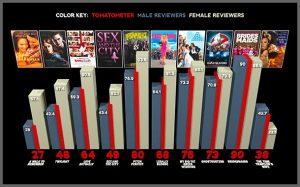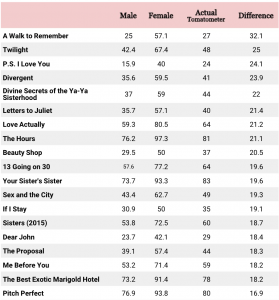Class Discussion 11/28: Ratings & Pleasures of Media Use
This Film Is Not Yet Rated
This documentary explains how movies are rated and the biases and agencies behind the ratings. These ratings are made by an anonymous group of parents who rate the film based on what they think is appropriate and inappropriate for children and teenagers to see. Certain societal structures and ISAs (family, church, etc.) in society about sexuality, violence, and language have created the standards they set for the movies. Movies featuring unfamiliar non-normative ideas, as well as independent movies are likely to reach the NC-17 or R rating. This hinders advertising for the movie which ultimately loses millions of dollars in revenue, as people are not aware of the movie or discouraged to see it because of the NC-17 or R rating.
Additionally, films featuring strong female sexuality and pleasure are typically rated R or NC-17 which disrupts representation of various aspects of women in film, as those movies do not make as much money as those featuring male sexuality and pleasure rated for younger audiences.
Salon.com: The Tomatometer gender gap is real
According to the Sa1on.com article, there is often a discrepancy between male and female ratings of female-centric movies. For example, the “Ghostbusters” reboot, received significantly higher scores from female critics than their male counterparts. While 79.3 percent of women who reviewed the film gave it a positive review, just 70.8 percent of male critics agreed with them. This is the typical pattern for female-centric movies, with about an 8 percent average difference in ratings between males and females. This leads to a lower Rotten Tomato Tomatometer score, which discourages people from seeing female-centric movies.
Additionally, movies labeled as “chick flicks” such as A Walk to Remember and Twilight had a larger difference in male and female ratings than movies such as The Notebook where males were given an equal weight in the narrative or movies that were “spunky comedies about relationships between women featuring backstabbing such as Bring It On and Mean Girls. Because higher rated movies receive more views and attention, this perpetuates stereotypes of women and teenage girls and decreases the depth of women characters in movies, as movie studios try to appeal to this same narrative.



Discussion Questions
In “This Film Is Not Yet Rated,” it talks about a group of anonymous parents who rate movies into the categories: G, PG, PG-13, R, and NC-17 or X. The ratings are meant to represent a parent’s view of the movie and whether it is or isn’t appropriate for children of all ages. To decide this, they create certain standards, which are idealized by societal norms. What structures of family, education, and religion are in place that create these standards and how do they continue to maintain societal norms? How does it limit representation to the masses of people who do not fit in the mold of “normal” families or religions.
Sex and sexuality is often a theme in PG-13, R, and NC-17 rated movies. The focus on sex and sexuality is more often than not from a male’s perspective (male writers, producers, directors, etc.). However, according to the documentary, when sex and pleasure is shown from the female perspective, it is considered more inappropriate and rated as such. Why do you think it is considered more inappropriate and rated as such?
According to the Sa1on.com article, there is often a discrepancy between male and female ratings of female-centric movies. For example, the “Ghostbusters” reboot, received significantly higher scores from female critics than their male While 79.3 percent of women who reviewed the film gave it a positive review, just 70.8 percent of male critics agreed with them. This is the typical pattern for female-centric movies, with about an 8 percent average difference in ratings between males and females. This leads to a lower Rotten Tomato Tomatometer score, which discourages people from seeing female-centric movies. How does this contribute to the lack of female opinions and representation in movies and media? Would a film featuring strong female sexuality from the female’s perspective receive an equal rating from men and women?
According to the Salon.com article, movies labeled as “chick flicks” such as A Walk to Remember and Twilight had a larger difference in male and female ratings than movies such as The Notebook where males were given an equal weight in the narrative or movies that were “spunky comedies about relationships between women featuring backstabbing such as Bring It On and Mean Girls. How does this perpetuate stereotypes of women being catty along with the “mean girl” stereotype, and media’s representation of women in movies? How is the government able to control and/or continue this if they are able to restrict media?
The reading from the textbook discusses the government’s restricting control on media including films, the internet, and video games. How does this allow for the government to control things based on the societal norms through police enforcing laws regarding media and the government controlling media, which can lead to decreased access of the public space of the internet and television?
